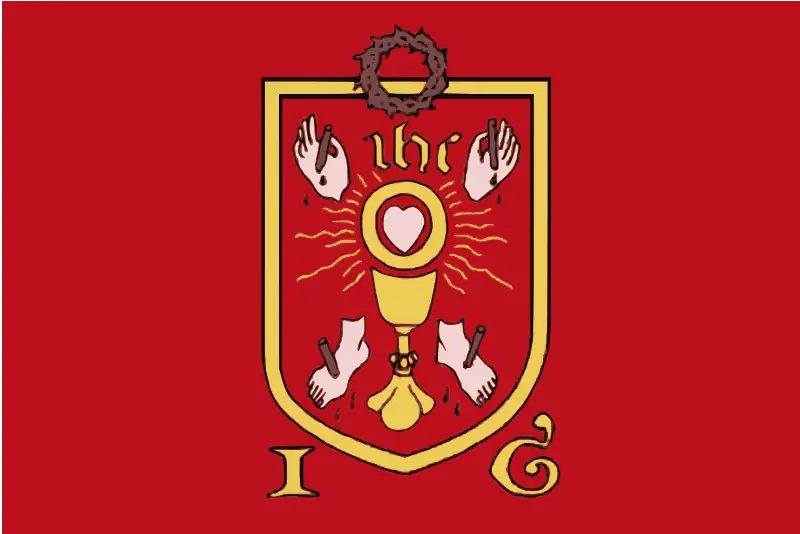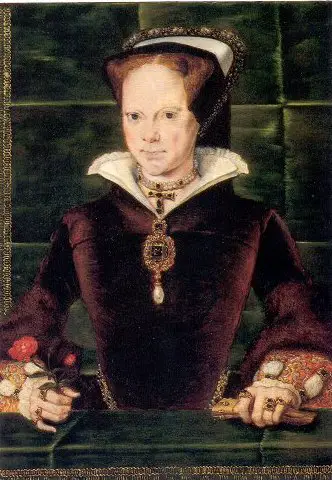 On Sunday 1st October 1553, Mary I was crowned queen at Westminster Abbey by Stephen Gardiner, Bishop of Winchester. She was the first crowned queen regnant of England.
On Sunday 1st October 1553, Mary I was crowned queen at Westminster Abbey by Stephen Gardiner, Bishop of Winchester. She was the first crowned queen regnant of England.
Here is a primary source account of the coronation ceremony from The chronicle of Queen Jane, and of two years of Queen Mary, and especially of the rebellion of Sir Thomas Wyat:
"Memorandum, the first daie of October, 1553, was quene Mary crowned; that daie she cam first by water to the old palice and ther tarryed tyll about xj. of the clocke, and then went to the churche on foot apon blew clothe being rayled on every syde; she was in a gown of blew velvett, lyned with pouderyd armyn, having the same cyrclet on hir hedd with the whiche she cam thorough London the daye before. She was ledd betwen one bushope and (blank), and many bishopes in their myters and crosiars before hir.
"In the churche, before she was anoynted, the lorde chauncellour went to the foure corners of the no . . (?) and cried, " Yf eny man will or can alledge eny cause whie quene Mary shoulde not be crowned, let theym speke now:" and then the people in every place of the churche cryed, " Quene Mary! quene Mary!" Then the bushope of Winchester, being lorde chauncellour, proclaymed the quenes pardon, wherin was excepted all prysoners in the Tower, the Flet, certayn in the Mershallsey, and suche as had eny comandement to kepe the house, and certayn other.
"Note, she was ledde iiij. or v. tymes on the alter, with so many and sondery cerymonyes in anoynting, crowning, and other olde customes, that it was past iij. almost iiij. of the clocke at night or ever she cam from the church agayn. And as she cam homeward ther was borne before her iij. swordes shethed, and one naked. She was ledd likewise betwen the old bushope of Dyrom and (blank), having in hir hande a cepter of golde, and in hir other hande a ball of golde, which she twirled and tourned in hir hande as she came homewarde. She wore a chrymesyn vellvet gown, and a crown on hir hedd, every rely [erle?] and contesse following in crymesyn vellvet with crownets on ther hedds of gold. When she was enteryd in Westminster hall ther was ill scramble for the cloth and rayles; then was ther the wast meat cast out of the ketchen made under the pallaice wall with bordes, which was very muche of all kinde of meat. And when they had don casting out meat ther was no lesse scrambling for the ketchyn yt self, every man that wolde plucking downe the hordes therof, and carying yt away, that yt might welbe callyd a wast indedde."
In his Annals of England to 1603 John Stow records:
"On the morrow, which was the first daie of October: the Queene went by water to the olde palace, and there remained till aboute eleven of the clocke, and then went on foote upon blew cloth, being railed on either side unto Saint Peters Church, where shee was solemnelie crowned and annointed by the Bishop of Winchester, which coronation and other ceremonies and solemnities then used according to the olde custome, was not fully ended till it was nigh foure of the clocke at night that shee returned from the Church before whom was then borne the swords sheathed and one naked. The great service that day done in Westminster hall at dinner by divers noble men would aske long time to write. The Lord maior of London and twelve citizens kept the high cupboord of plate as botlers, and the Queene gave to the Maior for his fee a cup of golde with a cover waying seventeene ounces."
Henry Machyn gives more details of the coronation banquet:
"[...] and ther her grace hard masse, and was crounyd a-pon a he [high] stage, and after [she was] a-nontyd Qwene, the forst day of October. [When all] was don, her grace cam to Westmynster hall . . . . . yt was iiij of the cloke or she whent to dener [or pa]st; and ther the duke of Norffoke rod up and done the hall, my lord the yerle of Darbe he [high] constabull, the yerle of Arundell he [high] boteler, and my lord of Borgane cheyff larderer, master Dymmoke the qwyen('s) champyon; and ther was [great me]lode; and the erle of Devonshyre bare the sword, and the yerle of Westmorland bare the cape of mantenans, and the erle of Shrowsbery bare the crowne, and the duke of Norffoke [was earl] marshall, and the yerle of Arundell lord stuard, and the erle of Surray was doer under the duke ys grandshyr, and the erle of Woseter was her grace('s) carver that day at dener, my lord Wyndsore was (blank); and at the end of the tabull dynyd my lade Elisabeth and my lade Anne of Cleyff; and so yt was candyll-lyght or her grace or she had dynyd, and so [anon] her grace toke barge."
And here is another account from Simon Renard to Philip of Spain:
"The next day, coronation-day, the Queen went from the Hall of Parliament and Justice to the church, in procession with the bishops and priests in full canonical dress, the streets being again covered with flowers and decked with stuffs. She mounted a scaffolding that was erected at the church for this purpose, and showed herself to the people. The Queen's coronation was proclaimed to them and the question asked of them if they were willing to accept her as their queen. All answered: Yes; and the ordinary ceremonies were then gone through, the Queen making an offering of silver and silken stuffs. The Bishop of Winchester, who officiated, gave her the sceptre and the orb, fastened on the spurs, and girt her with the sword; he received the oath, and she was twice anointed and crowned with three crowns. The ceremonies lasted from ten in the morning till five o'clock in the afternoon. She was carried from the church to the Parliament Hall where a banquet was prepared. The Queen sat on a stone chair covered with brocade, which they say was carried off from Scotland in sign of a victory, and was once used by the Kings of Scotland at their crowning; she rested her feet upon two of her ladies, which is also a part of the prescribed ceremonial, and ate thus. She was served by the earls and lords, Knights of the Order (Garter) and officers, each one performing his own special office. The meats were carried by the Knights of the Bath. These knights are made by the Kings on the eve of their coronation and at no other time; and their rank is inferior to the other Order. The Queen instituted twenty fresh ones. They are called Knights of the Bath because they plunge naked into a bath with the King and kiss his shoulder. The Queen being a woman, the ceremony was performed for her by the Earl of Arundel, her Great Master of the Household. The Earl Marshal (Duke of Norfolk) and the Lord Steward (Earl of Arundel) directed the ceremonies mounted on horseback in the great hall. When the banquet was over an armed knight rode in upon a Spanish horse and flung down his glove, while one of the Kings-of-arms challenged anyone who opposed the Queen's rights to pick up the glove and fight the Champion in single combat. The Queen gave him a gold cup, as it is usual to do. Meanwhile the earls, vassals, and councillors paid homage to her, kissing her on the shoulder; and the ceremonies came to an end without any of the interruptions or troubles that were feared on the part of the Lutherans, who would rejoice in upsetting the Queen's reign."
What a tiring day it must have been for Mary but also what a wonderful day.
Do read the other parts of this series too:
- Mary I's Coronation Part 1 - Mary travels to the Tower
- Mary I's Coronation Part 2 – Knights of the Bath
- Mary I's Coronation Part 3 - The Coronation Procession of Mary I
Tudor Society members can read all about Mary I in our Mary I ebook, part of our ebook series - click here.
Sources
- The chronicle of Queen Jane, and of two years of Queen Mary, and especially of the rebellion of Sir Thomas Wyat by a Resident in the Tower of London, ed. John Gough Nichols, Camden Society, 1850. Read at https://archive.org/stream/chronicleofqueen00nichuoft#page/26/mode/2up
- Annals of England to 1603, John Stow, read at https://archive.org/stream/annalsofenglandt00stow#page/n1065/mode/2up
- 'Diary: 1553 (Jul - Dec)', in The Diary of Henry Machyn Citizen and Merchant-Taylor of London (1550-1563), ed. J G Nichols (London, 1848), pp. 34-50 http://www.british-history.ac.uk/camden-record-soc/vol42/pp34-50.
- Calendar of State Papers, Spain, Volume 11, 3 October 1553, Simon Renard to Prince Philip. Read online at http://www.british-history.ac.uk/cal-state-papers/spain/vol11/pp261-272



There is a fabulous illuminated sketch within the P on the proceedings for Michelmas Law Term of 1553 in the National Archives at Kew. Probably painted by Levina Teerlinc – and it has all the hallmarks of the Flemish illuminators. How apt a woman artist should paint this P on the front of the proceedings of the first ever English Queen’s Bench.
I actually feel like singing Oh Happy Day with this wonderful description. I am quite transported back to Mary’s coronation. Thanks.
I’m so glad you enjoyed the article, it’s always good when you find such detailed contemporary records.
do you have a contact list and newsletter list?
Members receive a weekly email round-up and then tghe talks, magazine etc. are all on the website.
We send out weekly round-up emails to our members, yes.